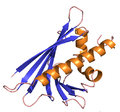Bet v I allergen
Bet v 1 allergen is a major protein responsible for birch pollen allergy, a prevalent form of allergic reaction especially common in the temperate regions of the Northern Hemisphere. It belongs to the PR-10 family of plant proteins and is considered the primary cause of Type I hypersensitivity reactions in individuals exposed to birch pollen. This article delves into the characteristics, structure, and implications of the Bet v 1 allergen.
Characteristics[edit]
Bet v 1 is a small, globular protein predominantly found in the pollen of birch trees (Betula species), hence its name. It is also present in various fruits, nuts, and vegetables, leading to what is known as Oral Allergy Syndrome (OAS) or pollen-food syndrome in sensitive individuals. The protein is highly stable and can trigger immune responses even in minimal quantities.
Structure[edit]
The Bet v 1 allergen has a tertiary structure that is highly conserved among members of the PR-10 protein family. It consists of a seven-stranded anti-parallel beta-sheet and two alpha-helices, forming a hydrophobic core. This core is thought to be involved in the binding of ligands, although the exact biological function of Bet v 1 remains unclear. The protein's ability to bind various ligands is believed to contribute to its allergenicity, as it may facilitate the presentation of the allergen to the immune system.
Allergic Reaction[edit]
When an individual with a sensitized immune system inhales birch pollen containing Bet v 1, the protein binds to IgE antibodies on the surface of mast cells and basophils. This binding triggers the cells to release histamine and other inflammatory mediators, leading to symptoms of allergic rhinitis, such as sneezing, nasal congestion, itchy eyes, and in severe cases, asthma.
Cross-Reactivity[edit]
One of the notable features of Bet v 1 is its cross-reactivity with proteins from other plants. This is due to the structural similarities between Bet v 1 and certain proteins found in fruits, nuts, and vegetables. Individuals allergic to birch pollen may therefore experience allergic reactions to foods containing these similar proteins, a phenomenon known as Oral Allergy Syndrome (OAS).
Diagnosis and Treatment[edit]
Diagnosis of Bet v 1 allergy typically involves skin prick tests or specific IgE blood tests to confirm sensitivity to birch pollen. Management of the allergy primarily focuses on symptom relief through the use of antihistamines, corticosteroids, and in some cases, allergen immunotherapy. Allergen immunotherapy, also known as desensitization, aims to reduce the immune system's sensitivity to the allergen over time.
Conclusion[edit]
Bet v 1 allergen is a significant contributor to birch pollen allergy and related food allergies through cross-reactivity. Understanding its structure and function is crucial for developing targeted therapies to alleviate the symptoms of allergic reactions in affected individuals.
Bet_v_I_allergen[edit]
-
1bv1
Ad. Transform your life with W8MD's Budget GLP-1 injections from $75


W8MD offers a medical weight loss program to lose weight in Philadelphia. Our physician-supervised medical weight loss provides:
- Weight loss injections in NYC (generic and brand names):
- Zepbound / Mounjaro, Wegovy / Ozempic, Saxenda
- Most insurances accepted or discounted self-pay rates. We will obtain insurance prior authorizations if needed.
- Generic GLP1 weight loss injections from $75 for the starting dose.
- Also offer prescription weight loss medications including Phentermine, Qsymia, Diethylpropion, Contrave etc.
NYC weight loss doctor appointmentsNYC weight loss doctor appointments
Start your NYC weight loss journey today at our NYC medical weight loss and Philadelphia medical weight loss clinics.
- Call 718-946-5500 to lose weight in NYC or for medical weight loss in Philadelphia 215-676-2334.
- Tags:NYC medical weight loss, Philadelphia lose weight Zepbound NYC, Budget GLP1 weight loss injections, Wegovy Philadelphia, Wegovy NYC, Philadelphia medical weight loss, Brookly weight loss and Wegovy NYC
|
WikiMD's Wellness Encyclopedia |
| Let Food Be Thy Medicine Medicine Thy Food - Hippocrates |
Medical Disclaimer: WikiMD is not a substitute for professional medical advice. The information on WikiMD is provided as an information resource only, may be incorrect, outdated or misleading, and is not to be used or relied on for any diagnostic or treatment purposes. Please consult your health care provider before making any healthcare decisions or for guidance about a specific medical condition. WikiMD expressly disclaims responsibility, and shall have no liability, for any damages, loss, injury, or liability whatsoever suffered as a result of your reliance on the information contained in this site. By visiting this site you agree to the foregoing terms and conditions, which may from time to time be changed or supplemented by WikiMD. If you do not agree to the foregoing terms and conditions, you should not enter or use this site. See full disclaimer.
Credits:Most images are courtesy of Wikimedia commons, and templates, categories Wikipedia, licensed under CC BY SA or similar.
Translate this page: - East Asian
中文,
日本,
한국어,
South Asian
हिन्दी,
தமிழ்,
తెలుగు,
Urdu,
ಕನ್ನಡ,
Southeast Asian
Indonesian,
Vietnamese,
Thai,
မြန်မာဘာသာ,
বাংলা
European
español,
Deutsch,
français,
Greek,
português do Brasil,
polski,
română,
русский,
Nederlands,
norsk,
svenska,
suomi,
Italian
Middle Eastern & African
عربى,
Turkish,
Persian,
Hebrew,
Afrikaans,
isiZulu,
Kiswahili,
Other
Bulgarian,
Hungarian,
Czech,
Swedish,
മലയാളം,
मराठी,
ਪੰਜਾਬੀ,
ગુજરાતી,
Portuguese,
Ukrainian

